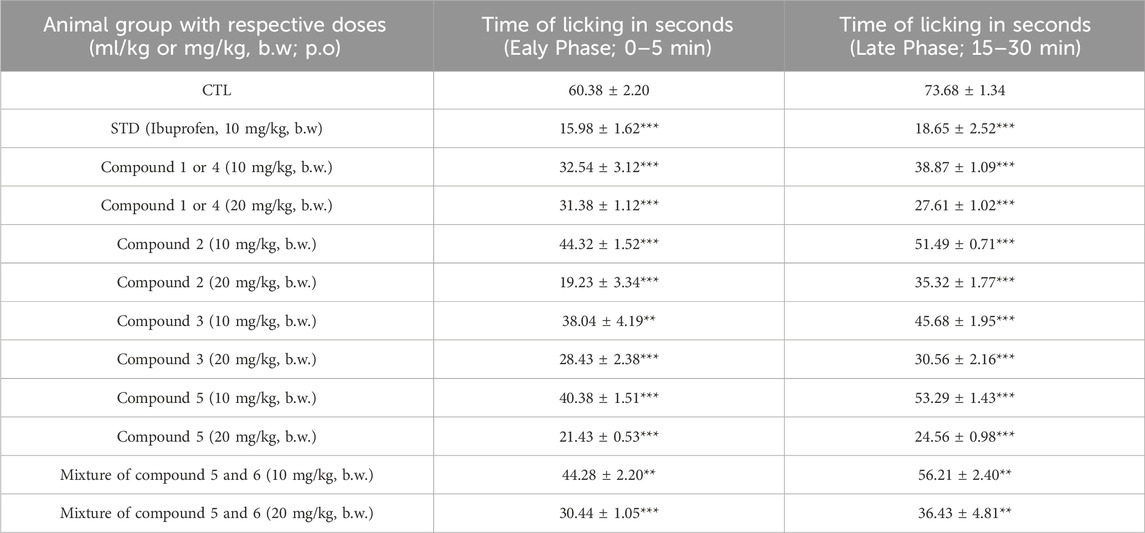- 1Chemical Research Division, BCSIR Dhaka Laboratories, Bangladesh Council of Scientific and Industrial Research (BCSIR), Dhaka, Bangladesh
- 2Department of Pharmaceutical Chemistry, Faculty of Pharmacy, University of Dhaka, Dhaka, Bangladesh
- 3Department of Pharmacy, Faculty of Science and Engineering, International Islamic University Chittagong, Chittagong, Bangladesh
A Corrigendum on
First-time report on compound isolation from two Colocasia species: vegetable-derived bioactive metabolites and their medicinal potential
by Alam S, Richi FT, Emon NU, Chowdhury AA, Hasan CM and Haque MR (2024). Front. Pharmacol. 15:1474706. doi: 10.3389/fphar.2024.1474706
In the published article, there was an error in the Footnote for “Table 3” as published. An incorrect expression was used; “[n = 5]” was used when this should have been “[n = 3]”. The corrected footnote appears below.
“Values are expressed as mean ± SEM (n = 3); CTL, negative control; STD, positive control; ***p < 0.001, **p < 0.01, *p < 0.05 compared to negative control.”
In the published article, there was an error in Table 4 as published. Columns 1-3 of “Table 3” were incorrectly replicated as Table 4. The corrected Table 4 and its caption appear below.

Table 4. Anti-inflammatory effect of the isolated compounds from C. gigantea and C. affinis on the formalin-induced mouse model.
In the published article, there was an error. The number of mice included in the control and test groups for pharmacological assessment was incorrect.
A correction has been made to Materials and Methods, Experimental design, In vivo tests, Antidiarrheal bioassay: castor oil-induced diarrhea test, Paragraph 1. This sentence previously stated:
“In this study, the mice were divided into four groups: control, positive control, and two test groups, each containing five mice.”
The corrected sentence appears below:
“In this study, the mice were divided into twelve groups: control, positive control, and ten test groups, each containing three mice.”
In the published article, there was an error. The number of mice included in the control and test groups for pharmacological assessment was incorrect.
A correction has been made to Materials and Methods, Experimental design, In vivo tests, Analgesic bioassay: acetic acid-induced writhing test, Paragraph 1. This sentence previously stated:
“In this study protocol, mice were divided into four groups: control, positive control, and two test groups, each containing five mice.”
The corrected sentence appears below:
“In this study protocol, mice were divided into twelve groups: control, positive control, and ten test groups, each containing three mice.”
In the published article, there was an error.
A correction has been made to Results, In vivo study, Effect of the identified test compounds on formalin-induced licking in the mice model, Paragraph 1. These sentences previously stated:
“C5 and C2 demonstrated the highest anti-inflammatory efficacy among the compounds evaluated, resulting in a 44.44% and 40.74% reduction in licking respectively, at a dose of 20 mg/kg. On the other hand, the standard drug ibuprofen led to a decrease of 77.78% at a dose of 10 mg/kg.”
The corrected sentences appear below:
“C5 and C2 demonstrated the highest anti-inflammatory efficacy among the compounds evaluated, resulting in a 64.50% and 68.15% reduction in licking during the early phase and a 66.66% and 52.06% reduction during the later phase, respectively, at a dosage of 20 mg/kg. On the other hand, the standard drug ibuprofen led to a decrease of 73.54% and 74.68% in early and late phase subsequently.”
The authors apologize for these errors and state that this does not change the scientific conclusions of the article in any way. The original article has been updated.
Publisher’s note
All claims expressed in this article are solely those of the authors and do not necessarily represent those of their affiliated organizations, or those of the publisher, the editors and the reviewers. Any product that may be evaluated in this article, or claim that may be made by its manufacturer, is not guaranteed or endorsed by the publisher.
Keywords: Colocasia gigantea, Colocasia affinis, vegetable, NMR, antibacterial, antidiarrheal, analgesic, anti-inflammatory
Citation: Alam S, Richi FT, Emon NU, Chowdhury AA, Hasan CM and Haque MR (2025) Corrigendum: First-time report on compound isolation from two Colocasia species: vegetable-derived bioactive metabolites and their medicinal potential. Front. Pharmacol. 16:1541225. doi: 10.3389/fphar.2025.1541225
Received: 07 December 2024; Accepted: 01 April 2025;
Published: 11 April 2025.
Edited and reviewed by:
Alessandra Durazzo, Council for Agricultural Research and Economics, ItalyCopyright © 2025 Alam, Richi, Emon, Chowdhury, Hasan and Haque. This is an open-access article distributed under the terms of the Creative Commons Attribution License (CC BY). The use, distribution or reproduction in other forums is permitted, provided the original author(s) and the copyright owner(s) are credited and that the original publication in this journal is cited, in accordance with accepted academic practice. No use, distribution or reproduction is permitted which does not comply with these terms.
*Correspondence: Mohammad Rashedul Haque, aGFxdWVtckBkdS5hYy5iZA==
†ORCID: Safaet Alam, orcid.org/0000-0002-1831-2278; Fahmida Tasnim Richi, orcid.org/0000-0002-7271-4219; Nazim Uddin Emon, orcid.org/0000-0001-7567-4796; Abu Asad Chowdhury, orcid.org/0000-0003-0952-8250; Choudhury Mahmood Hasan, orcid.org/0000-0001-7026-4368; Mohammad Rashedul Haque, orcid.org/0000-0001-5980-3877
 Safaet Alam
Safaet Alam Fahmida Tasnim Richi
Fahmida Tasnim Richi Nazim Uddin Emon
Nazim Uddin Emon Abu Asad Chowdhury
Abu Asad Chowdhury Choudhury Mahmood Hasan
Choudhury Mahmood Hasan Mohammad Rashedul Haque
Mohammad Rashedul Haque